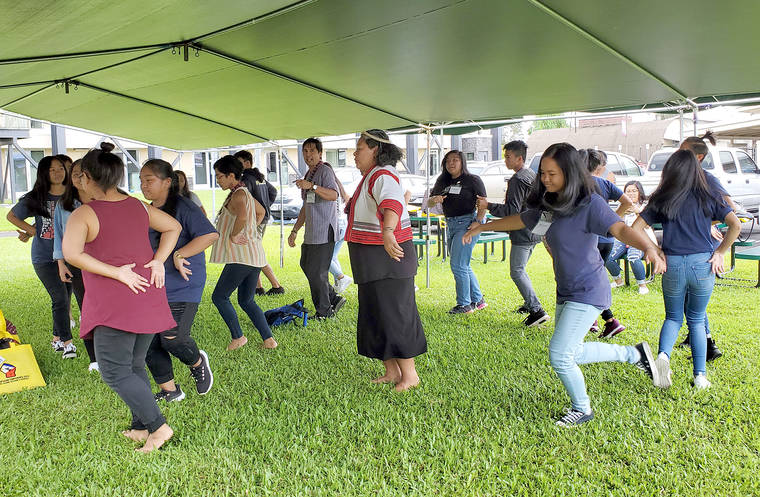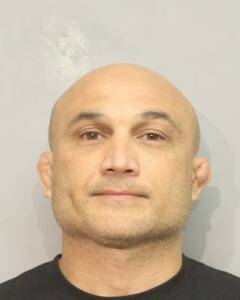Educators, administrators and students from throughout the University of Hawaii system gathered Friday at Hawaii Community College in Hilo to discuss ways to address the needs of Filipino students.
Participants at the 31st annual Pamantasan Conference were examining equity gaps for Filipino students and discussing what steps can be taken to advance the needs of those students.
Held in conjunction with Filipino American History Month, which is recognized in October, the conference also offered culture-based workshops for students to learn about their Filipino roots.
Just outside the cafeteria doors, a group of students danced.
Inside, members of a panel discussed, among other topics, representation of the Filipino community among students and administrators, and bridging the educational gap.
Christine Quemuel, interim assistant vice chancellor for diversity at the University of Hawaii at Manoa, said after the panel that “pamantasan” means higher education.
Those participating in the conference are “concerned with the representation of Filipinos on the UH campuses and in higher education,” she said. “We also talk about the different research that’s happening around Filipinos.”
At some community colleges, the Filipino student population is “actually over-represented,” Quemuel said.
“But then when you get to the four-year campuses, like UH-Hilo, West Oahu and Manoa, we’re under-represented in terms of undergrads,” she continued. “So that means, somehow, we’re making it to community colleges, but why aren’t we making it into the four-year campuses? Then when you look at graduate students, the numbers drop even more. So that’s one of the things we look at with our research is, why is that?”
From 2005-2018, Filipino students averaged about 15.4% of the community college students systemwide, 10.4% of undergraduate students and 4.5% of graduate students.
“Even at the community college, I think our Filipino students are still not getting Filipino history,” said Leon Florendo, a counselor at Leeward Community College Waianae Moku on Oahu.
“One of the reasons we want to teach them about their history and their culture is to install a sense of pride, because one of the things that we see with some of our students is they’re kind of embarrassed to be Filipino because of some of the stereotypes that exist about being Filipino in Hawaii, so we want to flip that and make them proud of their history, proud of their heritage,” Quemuel said.
Florendo said that according to data, Filipino students who transfer to four-year institutions are successful.
Data shows these students are graduating, he said, “but we need to get them there. So how do we address that? And that’s been the million-dollar question. If we were able to solve it 30 years ago … then we’d be doing something different. We’d be addressing some other issue.”
HCC Chancellor Rachel Solemsaas said it was an honor for the campus to host nearly 230 people for the conference.
Solemsaas said parity is an issue.
“So when we have about 25% of our population of Filipino ancestry, and so far records show that only 10% are going to and completing college, we know we have to achieve parity … ,” she said. “And certainly for me being Filipino-American myself, it’s close to my heart, because every part of our community, from whatever background they come, particularly how multicultural we are, we want to make sure everybody has an opportunity to succeed and to serve. So that’s why it’s critical.”
Racquel Raneses, a graduate student at UH-Manoa Myron B. Thompson School of Social Work, attended the conference for the first time this year.
“I always heard amazing, great things about this conference and how it encourages students, even high school students, to dig deeper into their cultural identities, their ancestry and finding the richness of who they are as individuals as Filipinos.”
She wanted to be a part of that and said attending the conference was an “amazing” experience.
“Growing up in Hawaii on Oahu, you do everything your parents tell you to do,” she said. “You go to college, you go to school, you get a job. They don’t tell you about all the things in the middle — what’s supposed to be important to you and what you’re supposed to fight after and chase after. It was through going to college and in my undergrad that I discovered that the Philippines and Filipinos have their deep, rich history that goes beyond just food and the butt-ends of jokes. … It’s investing in my future by digging deeper into my history and my culture.”
This year’s conference came after Gov. David Ige signed a pamantasan bill in July that appropriated funding to UH for two full-time positions to promote access, diversity and workforce development, including programs and policies related to Philippine courses and Filipino students
Email Stephanie Salmons at ssalmons@hawaiitribune-herald.com.






